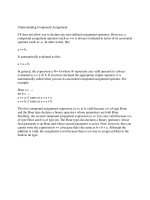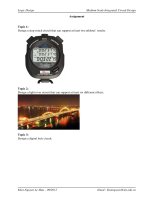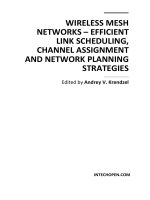1651 huynhhuuhoang gcs210952 assignment 1re
Bạn đang xem bản rút gọn của tài liệu. Xem và tải ngay bản đầy đủ của tài liệu tại đây (907.51 KB, 22 trang )
Higher Nationals in Computing
Unit 20: Advanced Programming
ASSIGNMENT 1
Learner’s name:
ID:
Class:
Subject code: 1651
Assessor name: PHAN MINH TAM
Assignment due:
Assignment submitted:
ASSIGNMENT 1 FRONT SHEET
Qualification
BTEC Level 5 HND Diploma in Computing
Unit number and title
Unit 20: Advanced Programming
Submission date
Date Received 1st submission
Re-submission Date
Date Received 2nd submission
Student Name
HUYNH HUU HOANG
Student ID
GCS210952
Class
GCS1007
Assessor name
Phan Minh Tam
Student declaration
I certify that the assignment submission is entirely my own work and I fully understand the consequences of plagiarism. I understand that
making a false declaration is a form of malpractice.
Student’s signature
Grading grid
P1
P2
M1
M2
D1
D2
Summative Feedback:
Grade:
Signature & Date:
Resubmission Feedback:
Assessor Signature:
Date:
ASSIGNMENT 1 BRIEF
Qualification
BTEC Level 5 HND Diploma in Business
Unit number
Unit 20: Advanced Programming
Assignment title
Examine and design solutions with OOP and Design Patterns
Academic Year
Unit Tutor
Issue date
Submission date
IV name and date
Submission Format:
Format:
The submission is in the form of a group written report and presentation. This should be
written in a concise, formal business style using single spacing and font size 12. You are
required to make use of headings, paragraphs and subsections as appropriate, and all work
must be supported with research and referenced using the Harvard referencing system.
Please also provide a bibliography using the Harvard referencing system.
Submission Students are compulsory to submit the assignment in due date and in a way requested by
the Tutors. The form of submission will be a soft copy in PDF posted on corresponding
course of />Note:
The Assignment must be your own work, and not copied by or from another student or from
books etc. If you use ideas, quotes or data (such as diagrams) from books, journals or other sources, you
must reference your sources, using the Harvard style. Make sure that you know how to reference
properly, and that understand the guidelines on plagiarism. If you do not, you definitely get fail
Assignment Brief and Guidance:
Scenario: You have recently joined a software development company to help improve their documentation of
their in-houses software libraries which were developed with very poor documentation. As a result, it has been
very difficult for the company to utilise their code in multiple projects due to poor documentation. Your role is to
alleviate this situation by showing the efficient of UML diagrams in OOAD and Design Patterns in usages.
Tasks
You and your team need to explain characteristics of Object-oriented programming paradigm by
applying Object-oriented analysis and design on a given (assumed) scenario. The scenario can be
small but should be able to presents various characteristics of OOP (such as: encapsulation,
inheritance, polymorphism, override, overload, etc.).
The second task is to introduce some design patterns (including 3 types: creational, structural and
behavioral) to audience by giving real case scenarios, corresponding patterns illustrated by UML class
diagrams.
To summarize, you should analyze the relationship between the object-orientated paradigm and
design patterns.
The presentation should be about approximately 20-30 minutes and it should be summarized of the
team report.
Learning Outcomes and Assessment Criteria
Pass
Merit
Distinction
LO1 Examine the key components related to the object-orientated programming paradigm,
analysing design pattern types
P1 Examine the
characteristics of the objectorientated paradigm as well
as the various class
relationships.
M1 Determine a design pattern
from each of the creational,
structural and behavioural
pattern types.
D1 Analyse the relationship
between the object-orientated
paradigm and design patterns.
LO2 Design a series of UML class diagrams
P2 Design and build class
diagrams using a UML tool.
M2 Define class diagrams for
specific design patterns using a
UML tool.
D2 Define/refine class
diagrams derived from a given
code scenario using a UML tool.
Table of Contents
Unit 20: Advanced Programming ASSIGNMENT 1 .................................................................................................... 1
ASSIGNMENT 1 ANSWERS ........................................................................................................................................ 1
P1. OOP general concepts ....................................................................................................................................... 1
I. What is OOPs ..................................................................................................................................................... 1
1. Class and Object ........................................................................................................................................... 1
a. Class .......................................................................................................................................................... 1
b. Object ....................................................................................................................................................... 3
2. Inheritance ................................................................................................................................................... 4
3. Polymorphism .............................................................................................................................................. 5
4. Encapsulation ............................................................................................................................................... 5
5. Abstraction ................................................................................................................................................... 6
II. Object oriented relationship ........................................................................................................................... 7
1. Inheritance: .................................................................................................................................................. 7
2. Composition: ................................................................................................................................................ 8
3. Association: .................................................................................................................................................. 9
4. Aggregation ................................................................................................................................................ 10
P2. Design and build class diagrams using a UML tool ...................................................................................... 11
1. Scenario .............









